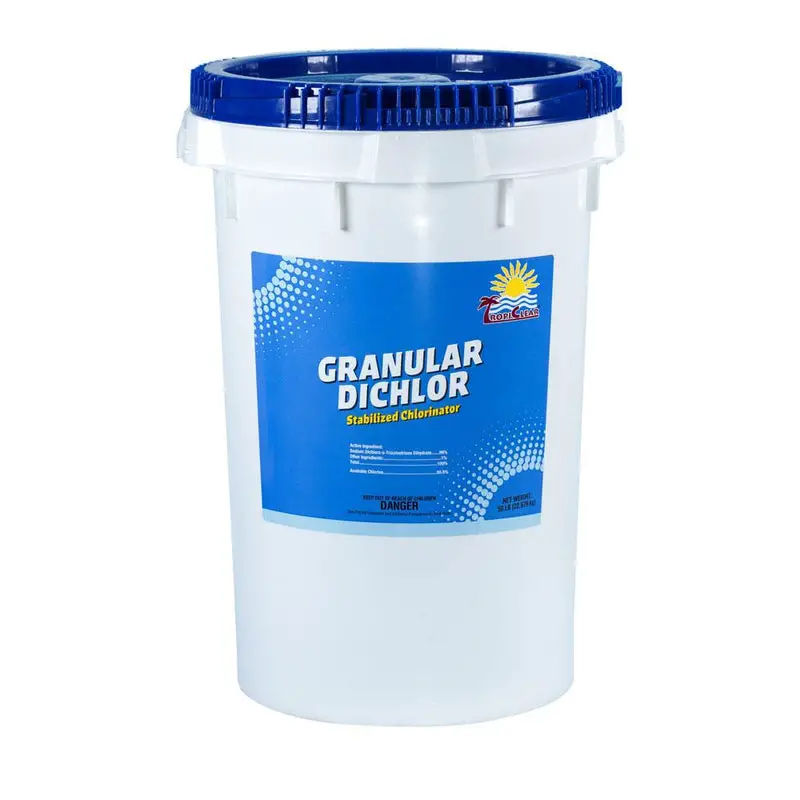Calcium hypochlorite has a higher level of available chlorine compared to sodium dichloro s triazinetrione. Calcium hypochlorite contains 65-70% of available chlorine while sodium dichloro s triazinetrione contains 55-60%.
Calcium hypochlorite and sodium dichloro s triazinetrione are both widely used for water disinfection purposes. However, knowing the differences between these two chemicals can help in choosing the best option for specific situations. In this article, we will explore the similarities and differences between calcium hypochlorite and sodium dichloro s triazinetrione to make an informed decision about which one to choose.

Credit: www.amazon.com
Understanding Chlorine Sanitizers
Chlorine sanitizers are a crucial component in water treatment. They kill bacteria and other microorganisms, making the water safe to consume and use. Calcium hypochlorite and sodium dichloro s triazinetrione are two popular types of chlorine sanitizers. Calcium hypochlorite, also known as cal-hypo, is ideal for shock treatments and can be easily stored in dry form.
Sodium dichloro s triazinetrione, or dichlor, is slow-dissolving and perfect for a continuous sanitizer. Both are effective, but choosing the right sanitizer depends on the specific needs and usage of the water source. Using the appropriate chlorine sanitizer and maintaining the correct levels is necessary for ensuring clean and safe water.
Calcium Hypochlorite: Pros And Cons
Calcium hypochlorite is a powerful and cost-effective pool sanitizing agent. It is often used in pool maintenance as it can function as a shock or swimming pool sanitizer. Calcium hypochlorite works as a powerful oxidizer that efficiently sanitizes pool water by breaking down bacteria, viruses, algae and other microorganisms present.
Compared to other pool cleaning agents, calcium hypochlorite is relatively low cost, easy to use and offers greater potency, requiring smaller amounts of chemical to be used. Calcium hypochlorite can be harmful if not handled with care. Inhaling or ingesting it can result in serious health risks and it can cause skin irritation.
Therefore, it should always be stored in a safe place and used with caution.
RiverbendPoolSupply.com – Chemistry School – Chlorine – Swimming Pool Supply
Sodium Dichloro S Triazinetrione: Pros And Cons
Sodium dichloro s triazinetrione, or sdt, is a powerful and efficient water disinfectant that eliminates bacteria, viruses and other harmful contaminants from water systems. It works by releasing chlorine, which oxidizes and neutralizes harmful pathogens. The advantages of using sdt include its fast acting qualities and effectiveness against a wide range of contaminants.
Additionally, it is easy to use and store. However, improper storage and handling can lead to harmful emissions and safety hazards. Sdt is an effective solution for water disinfection but requires careful handling to ensure safety measures are followed.
Comparison Between Calcium Hypochlorite And Sodium Dichloro S Triazinetrione
Calcium hypochlorite and sodium dichloro s triazinetrione are commonly used as disinfectants in many industries. Calcium hypochlorite is primarily composed of calcium ions, oxygen, and chlorine, while sodium dichloro s triazinetrione is made up of sodium, oxygen, nitrogen, and chlorine.
Both disinfectants are highly effective in killing microorganisms, but calcium hypochlorite is more stable in varying conditions. Sodium dichloro s triazinetrione, on the other hand, quickly loses its potency when exposed to sunlight and high temperatures. Both disinfectants have environmental impacts, with calcium hypochlorite being more harmful due to its high chlorine content.
Therefore, when choosing between these two disinfectants, it is essential to consider their chemical composition, effectiveness in killing microorganisms, stability in different conditions, and environmental impact.
The Best Chlorine Sanitizer For Your Needs
When choosing a chlorine sanitizer, it’s important to consider a few factors. First, you need to determine what your needs are. Is it for a residential or commercial swimming pool? Next, consider the pros and cons of each sanitizer. Calcium hypochlorite is a stronger oxidizer, but can be more difficult to handle and store.
Sodium dichloro s triazinetrione is easier to use and store, but may not be as effective in controlling algae growth. Ultimately, the decision should be based on your specific needs and preferences. Be sure to also follow proper handling and storage guidelines for whichever sanitizer you choose.
Frequently Asked Questions Of Calcium Hypochlorite Vs Sodium Dichloro S Triazinetrione
What Is Calcium Hypochlorite?
Calcium hypochlorite is a chemical compound commonly used for disinfecting water in swimming pools and as a bleaching agent in the textile industry.
What Is Sodium Dichloro S Triazinetrione?
Sodium dichloro s triazinetrione is a chemical compound often used for water disinfection in both industrial and residential settings.
What Are The Differences Between Calcium Hypochlorite And Sodium Dichloro S Triazinetrione?
Calcium hypochlorite is more commonly used for large-scale applications, while sodium dichloro s triazinetrione is ideal for small-scale and portable disinfection needs. Additionally, calcium hypochlorite requires more precautions when handling due to its higher corrosiveness.
What Are The Health Risks Involved With Using These Chemicals?
Both calcium hypochlorite and sodium dichloro s triazinetrione have the potential to irritate the eyes, skin, and respiratory system if not handled properly. It is important to follow safety guidelines when using these chemicals to minimize health risks.
Conclusion
To sum up, calcium hypochlorite and sodium dichloro s triazinetrione are both popular choices for water treatment, but they have important differences that should be taken into account before choosing one over the other. Calcium hypochlorite provides a high concentration of available chlorine and is cost-effective, but it can lead to corrosion and is less stable than sodium dichloro s triazinetrione.
On the other hand, sodium dichloro s triazinetrione is more stable and safer to handle but is more expensive and it may not provide the same level of effectiveness compared to calcium hypochlorite. Regardless of which option you choose, it is important to follow their specific instructions for safety and proper use.
Ultimately, the choice between the two will depend on your specific needs and preferences in terms of cost, efficacy, and safety. With this information, you can make an informed decision and ensure the safety and cleanliness of your water supply.
